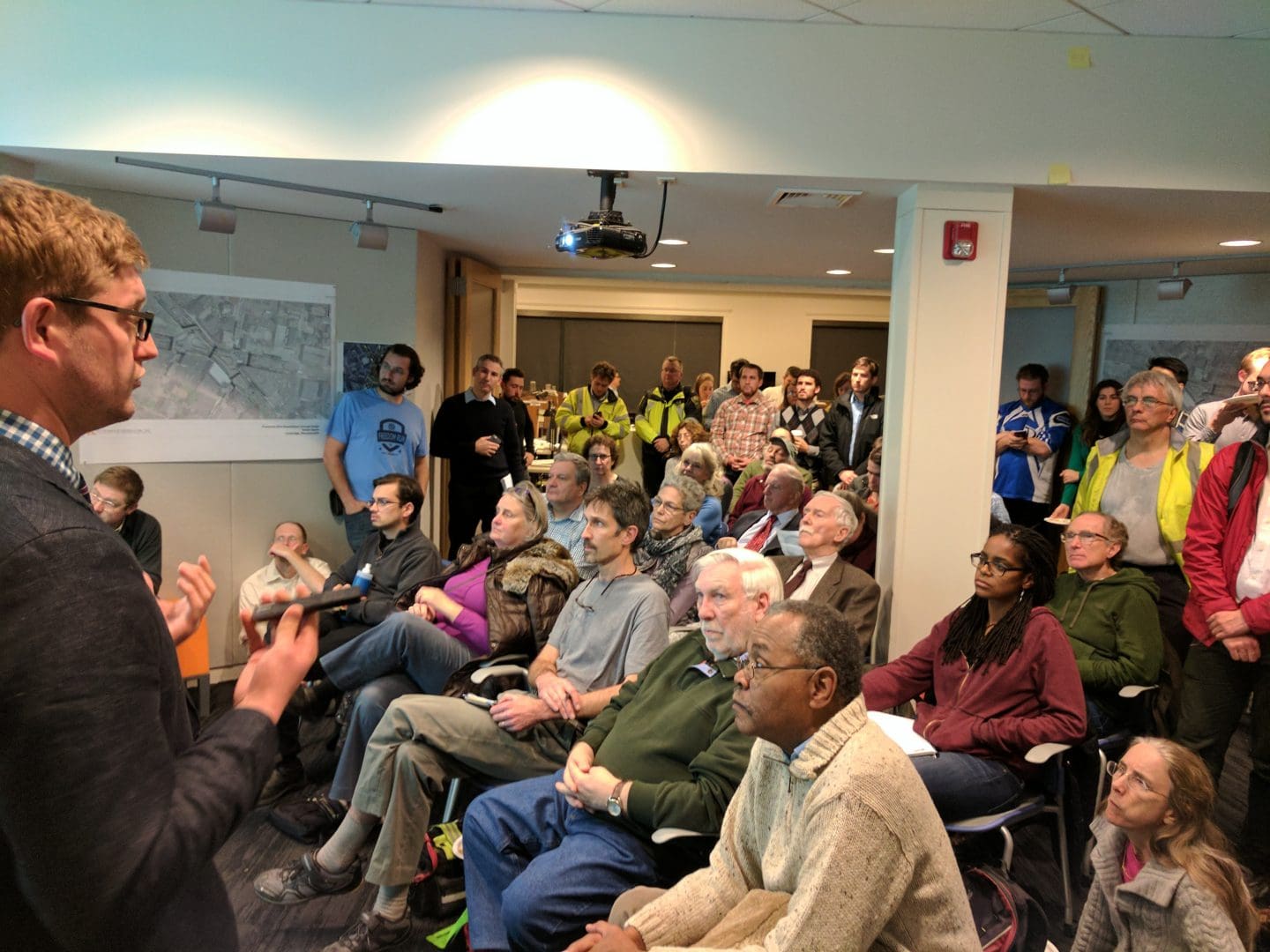February 7, 2017
The intersection of Hampshire Street and Cambridge Street in Cambridge, Massachusetts’ busy Inman Square presents a familiar challenge for cities. Due to its low-angle skew, the intersection expands over 250 feet, creating a confusing and chaotic environment for anyone passing through. With almost as many bicycles as cars on some approaches – not to mention pedestrians and buses – accommodating everyone is nearly impossible.
The City of Cambridge has been trying to come up with a solution to Inman Square since 2015. It has explored “squaring off” the intersection into two separate T-intersections of various incarnations. But the constrained environment and closely spaced intersections limit opportunities to create a walkable, bikeable place in this busy square.
Without an obvious conventional solution, local advocates recognized the need to innovate. A braintrust, featuring the Boston Cyclists Union, Cambridge Bicycle Safety, and Harvard researcher Anne Lusk, sought inspiration from northern Europe to solve Inman Square. In Germany, the Netherlands, and many other countries, roundabouts with separated bike lanes and sidewalks are frequently used to meet the needs of all travelers. Dr. Lusk began searching for a professional planning and engineering firm with expertise in both pedestrian and bicycle design and roundabouts, which led her to Kittelson & Associates’ (Kittelson) Boston office.
“We have been fortunate to work at the cutting edge of both bicycle design and roundabout design, so this opportunity couldn’t have been more perfect,” reflected Conor Semler, who led the project for Kittelson. “We’ve been looking for an opportunity to bring the Dutch bicycle treatment at roundabouts for years now, and Inman Square seemed like a place this could really work.” Initial operations assessments suggested the design was feasible, so the team began digging into the design.
Building off growing U.S. guidance and international best practices, the Kittelson team began designing a roundabout for the Hampshire Street/Cambridge Street intersection. Previous efforts to fit a roundabout in Inman Square failed due to a lack of space. But the Kittelson design team identified a solution using a pair of mini-roundabouts connected in the middle. Building off the firm’s position at the forefront of roundabout and bicycle design, this creative solution became possible. The resulting peanut-shaped, protected mini-roundabout would lead the Boston Cyclists’ Union to coin the term “peanutabout.”
The next step was to create a place for bicyclists and pedestrians to traverse the intersection safely and comfortably. “The priority of this design was to create a place that is comfortable and safe to walk and ride a bike, then to accommodate traffic, including trucks, buses, and emergency vehicles,” said Alek Pochowski , the lead designer for Kittelson. This meant sidewalk level bike lanes around the outside, with raised crosswalks wherever pedestrians had to cross the street. Combined with naturally slower traffic, the peanutabout would easily be the most comfortable design for people on foot and bike. The design also allows emergency vehicles, large trucks, and buses to safely maneuver the mini-roundabout by driving over the truck aprons and smaller central island.
Mini-roundabouts, peanut-shaped roundabouts, and roundabouts with sidewalk-level bike lanes around the outside are all relatively foreign in the U.S. Combined together, this design is the first of its kind in the country. The team knew it was important to get out in front of these hurdles in several ways. First, where possible, the design was inspired by existing U.S. guidance. MassDOT’s Separated Bike Lane Guide included a preliminary concept for treating separated bike lanes at roundabouts, which the designers pointed to in early meetings. Second, the principle-based design approach in NCHRP Report 672: Roundabouts, An Informational Guide, Second Edition, developed by Kittelson, was used to inform the design, and help assess tradeoffs necessary in the constrained urban environment. Next, Kittelson’s Aditya Inamdar brought the design to life with a beautiful 3-D rendering. And finally, the Cyclists Union and Kittelson convened an open house with the community in advance of the City’s public meetings to solicit feedback on the design.

Kittelson collects community feedback on the initial peanutabout design.
Working alongside the City of Cambridge, the design team revised the original drawing to meet some community requests, including:
- smoother bicycle movements through the intersection;
- the creation of open space on the north side of the intersection;
- reversing Antrim Street;
- maintaining separated bike lanes on all approaches; and
- improving accommodation for trucks, buses, and emergency vehicles.
The initial concept for the peanutabout was well-received, but residents, commuters, and City officials identified opportunities to improve on the design.
These changes were made possible by shifting the intersection west, which relocated some open space from Vellucci Park to the north side of the intersection.
In late January, the peanutabout was presented alongside several other alternatives to clean up Cambridge’s Inman Square. Should the mini-roundabout concept receive public support it will move into the next phase of analysis and design, including microsimulation to better understand the complex interactions between all street users. Cambridge hopes to begin constructing the ultimate solution by fall 2017. If successful, the peanutabout could become an option in the toolbox of solutions for skewed intersections across the nation.
